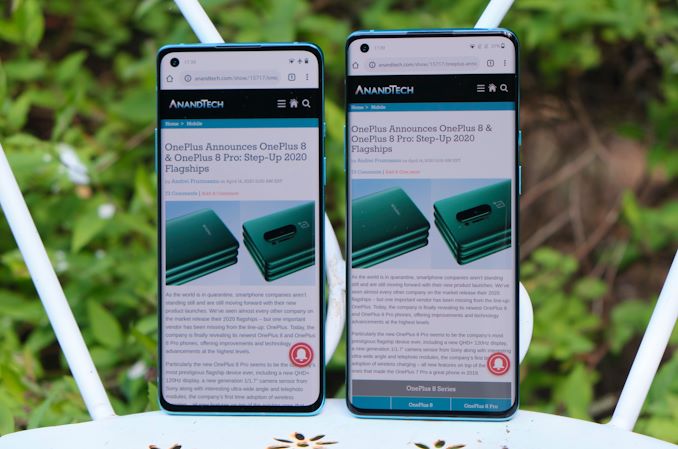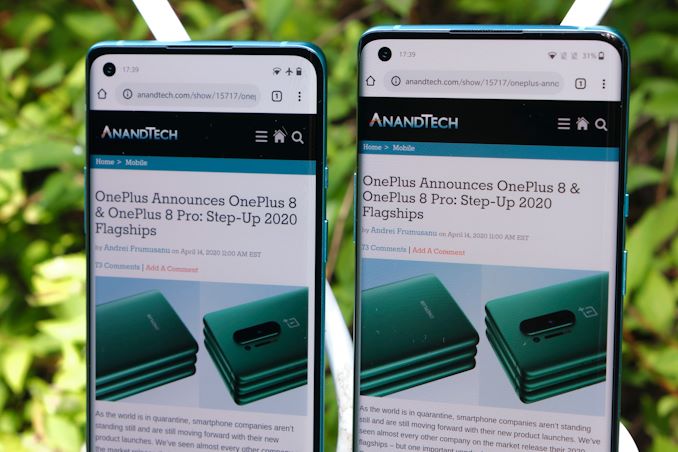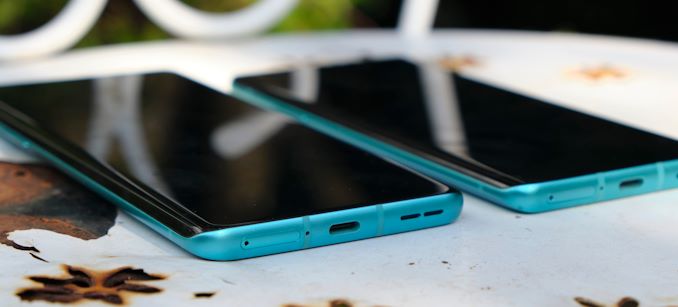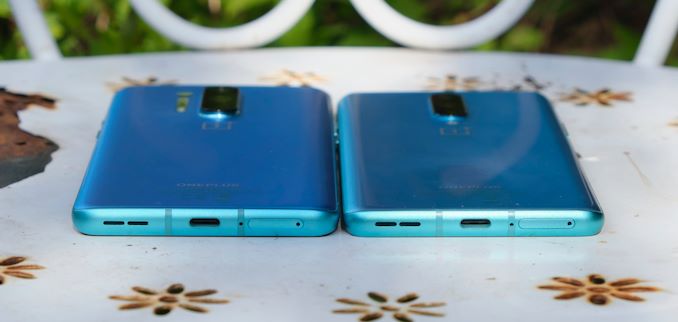The OnePlus 8, OnePlus 8 Pro Review: Becoming The Flagship
by Andrei Frumusanu on June 29, 2020 10:00 AM EST
It’s been a couple of months since OnePlus released the new OnePlus 8 & OnePlus 8 Pro, and both devices have received plenty of software updates improving the device’s experiences and camera qualities. Today, it’s time to finally go over the full review of both devices, which OnePlus no longer really calls “flagship killers”, but rather outright flagships.
The OnePlus 8, and especially the OnePlus 8 pro are big step-up redesigns from the company, significantly raising the bar in regards to the specifications and features of the phones. The OnePlus 8 Pro is essentially a check-marked wish-list of characteristics that were missing from last year’s OnePlus 7 Pro as the company has addressed some of its predecessors’ biggest criticisms. The slightly smaller and cheaper regular OnePlus 8 more closely follows its predecessors’ ethos as well as competitive pricing, all whilst adopting the new design language that’s been updated with this year’s devices.
| OnePlus 8 Series | ||
| OnePlus 8 | OnePlus 8 Pro | |
| SoC | Qualcomm Snapdragon 865 1x Cortex-A77 @ 2.84GHz 3x Cortex-A77 @ 2.42GHz 4x Cortex-A55 @ 1.80GHz Adreno 640 @ 587MHz |
|
| Display | 6.55-inch FHD+ 2400 x 1080 (20:9) 90Hz Refresh Rate |
6.78-inch QHD+ 3160 x 1440 (19.8:9) 120Hz Refresh Rate |
| SAMOLED HDR10+ |
||
| Dimensions | 160.2 x 72.9 x 8.0 mm 180 grams |
165.3 x 74.4 x 8.8 mm 199 grams |
| RAM | 8/12GB LPDDR4X | 8/12GB LPDDR5 |
| NAND Storage |
128/256 GB UFS 3.0 | |
| Battery | 4300mAh (16.55Wh) typ. | 4510mAh (17.36Wh) typ. |
| 30W Fast Charging | ||
| - | 30W Wireless Fast Charging (only via proprietary charger) 5W Qi Wireless Charging |
|
| Front Camera | 16MP f/2.0 |
16MP f/2.4 |
| Primary Rear Camera | 48MP 0.8µm 1/2" IMX586 (12MP 1.6µm 2x2 binning) f/1.75 w/ OIS |
48MP 1.12µm 1/1.4" IMX689 (12MP 2.24µm 2x2 binning) f/1.78 w/ OIS |
| Secondary Rear Camera |
16MP Ultra-Wide-Angle f/2.2 116° FoV |
48MP Ultra-Wide-Angle f/2.2 120° FoV |
| Tertiary Rear Camera |
2MP Macro Camera f/2.4 |
8MP Telephoto f/2.4 |
| Extra Camera |
- | 5MP Colour Sensor f/2.4 |
| 4G / 5G Modem |
Snapdragon 5G - Snapdragon Modem X55 (Discrete) (LTE Category 24/22) DL = 2500 Mbps - 7x20MHz CA, 1024-QAM UL = 316 Mbps 3x20MHz CA, 256-QAM (5G NR Sub-6) DL = 7000 Mbps UL = 3000 Mbps mmWave for OnePlus 8 (non-Pro) on Verizon in the US |
|
| SIM Size | NanoSIM + NanoSIM | |
| Wireless | 802.11a/b/g/n/ac/ax BT 5.1 LE, NFC, GPS/Glonass/Galileo/BDS |
|
| Connectivity | USB Type-C no 3.5mm jack |
|
| Special Features | On-screen fingerprint sensor, Stereo Speakers |
|
| IP68 Rating | ||
| Launch OS | Android 10 w/ Oxygen OS | |
| Launch Prices | 8+128GB: $699 / 699€ 12+256GB: $799 / 799€ |
8+128GB: $899 / 899€ 12+256GB: $999 / 999€ |
Starting off with the specs, both phones are powered by Qualcomm’s newest Snapdragon 865 SoC, which means they’ll be both delivering amongst the best performance and experience that one can have on an Android device today. One notable difference in the hardware specifications is that the regular OnePlus 8 comes with 8/12GB of LPDDR4X whilst the 8 Pro comes with 8/12GB of newer LPDDR5X. It’s an interesting choice, but we’ll see that the actual end result in performance and efficiency isn’t exactly what you would have expected, and is actually negligible. OnePlus is configuring both phones with either 128 or 256GB of UFS 3.0 storage.
The phones’ key characteristics is their new screens. The big change for the regular OnePlus 8 is the fact that it now adds a 90Hz refresh rate to its 2400 x 1080 OLED screen, a feature previously only present on the Pro model. Essentially this brings the high-refresh rate feature down in the product stack, something we’ve even seen from other vendors in the high-mid-end or “premium” stack.
The bigger OnePlus 8 Pro naturally has to one-up this, and it’s 3160 x 1440 OLED screen is now capable of a 120Hz refresh rate. The big difference for the 8 Pro versus other 120Hz contenders such as the Galaxy S20 series is the fact that OnePlus allows this refresh rate at the full native QHD resolution of the panel, whilst Samsung is forcing users to choose between 120Hz and 1440p resolution.
The regular OnePlus 8 comes with a 6.55” diagonal screen whilst the 8 Pro has a slightly larger 6.78” form-factor and that’s a key differentiating factor for the two devices’ footprints.
One big generational change in the design of the phones is in the front camera setup. Both phones now feature a left corner positioned hole cut-out for the front camera. The diameter of the cut-out isn’t all too different to what we’re seeing on the S20 series, but I find the corner placement to be maybe less intrusive, and it also allows OnePlus to actually house a much better (stereo) designed earpiece speaker compared to the S20’s series.
Some people were a fan of the mechanical pop-up camera of the OnePlus 7 Pro, but I was never really convinced by it given the technical compromises the phone had to make, especially in regards to thickness and weight. The OnePlus 8 Pro now is able to use this reclaimed space for internal components, a bigger battery, IP68 rating, all whilst even being lighter than the OnePlus 7 Pro – good riddance to the pop-up camera.
The rears of the phones retain the company’s “signature” central vertical camera setup which is actually something rare to see in 2020 as most other manufacturers have opted for a corner camera module layout, in this regard, even though OnePlus didn’t change anything, they do stick out.
The regular OnePlus 8 comes with a triple-camera setup amongst which there’s only two “real” daily usable modules. The main camera sensor here is the same as we’ve found on the OnePlus 7 series in the form of an 48MP IMX586, accompanied by a 16MP ultra-wide-angle module. The third camera is a dedicated 2MP macro module.
The OnePlus 8 Pro significantly upgrades the camera capabilities and here it’s where the phone outright competes with the best flagship devices on the market. The new main camera sensor is still 48MP, however this is a new IMX689 in a larger 1/1.4” sensor format – meaning the pixel pitch increases from 0.8µm to 1.12µm, effectively more than doubling the per-pixel and sensor area, as well as doubling the light gathering ability of the sensor.
The ultra-wide-angle module is also significantly upgraded – it’s now actually using the same 48MP sensor that the OnePlus 7 series and OnePlus 8 use for their main cameras, making the 8 Pro’s UWA amongst the highest specced on the market right now.
The 8 Pro has a quad-camera setup, 3 of which are usable in daily photography. The third module is the same 3x telephoto camera we’ve seen on the OnePlus 7 Pro. The fourth camera is a 5MP “colour filter module” which essentially is a regular camera with the IR filter removed, meaning it can capture IR wavelengths which can result in unique looking pictures, especially in sunlight.
One aspect I wanted to talk a bit more was the ergonomics of the phones, particularly their respective sizes as well as different screen curvature designs.
The first time I unpacked the regular OnePlus 8 out of its box and held it I had something akin to a revelation, as the phone outright felt as amongst the most perfect form-factors and ergonomics I’ve felt in a device in years. The phone felt incredibly premium – and although we’ve had glass sandwiches for years, this was by far the best feeling glass sandwich to date.
Holding the bigger OnePlus 8 Pro didn’t quite have the same response. Beyond it being a bit bigger which is subjective, the phone’s curves just weren’t as smooth. The big difference between the two units here is that the 8 Pro’s display glass curves to the sides with a much larger radius than the OnePlus 8.
Looking at both phones from the sides it’s obvious that the OnePlus 8 Pro’s metal side-frame isn’t actually centred, but actually more recessed towards the back of the phone. This makes it have a smaller back glass curvature compared to the regular OnePlus 8, and I think that this makes for quite a big difference in the ergonomics of the two phones.
We’ve had a lot of vendors experiment with curved front glass designs, ranging from the more conservative to more absurd 90° curves. Samsung most notably has toned down the front glass curvature on the S20 series and it’s actually been an improvement in the usability and feel of the phone. I think the OnePlus 8 Pro here also has a similar issue in that its front glass is too curved, whilst the OnePlus 8’s symmetric curves feel essentially perfect in-hand.
A form-factor difference between the two phones besides the footprint, is that the OnePlus 8 Pro is 0.8mm thicker. This doesn’t sound much, but it’s actually 10% difference between the two units and is immediately noticeable if you hold them side-by-side, but it’s not a major draw-back by its own. The 8 Pro is able to house a bigger 4510mAh battery, a slight bump over the 4300mAh unit of the regular OnePlus 8.
The camera bump on the 8 Pro is also slightly bigger than the one on the 8. It is sort of noticeable as the metal lip is protruding a lot more – however I found that given its central location on the phone I didn’t actually touch it all too often. Oh – and because the cameras are centred, it means the phone don’t wobble on a flat surface – something which is again a problem for most other 2020 devices.
The two sample units I received were “Glacial Green” flavours, although in pretty much in a lot of lightning conditions these actually appear as light blue. OnePlus’ usage of frosted matte glass textures on the back of the phones in this flavour makes this the no-brainer colour choice as it really augments the feeling of the device compared to the other glossy finishes.
Overall, I think OnePlus did excellently in terms of the design of the two phones. I was particularly enamoured with the regular OnePlus 8 as its form-factor and ergonomics are essentially the best I’ve felt in a phone in a very long time.
















92 Comments
View All Comments
Daro - Tuesday, June 30, 2020 - link
Agreed. I like google cloud ecosystem (maps, photos, etc) but the android phones are getting worse every day and iphones better.Speedfriend - Tuesday, June 30, 2020 - link
Alufan, you can't delete the Apple apps either so they have just as much bloatware as Android. And you can't change the default apps either though that change is coming.star-affinity - Sunday, July 12, 2020 - link
Quite a few of the standard apps on an iPhone can be deleted and re-downloaded from the App Store. But I guess not all – att least not the App Store app. :Dstar-affinity - Sunday, July 12, 2020 - link
att = atQuantumz0d - Monday, June 29, 2020 - link
I agree, Google is all in copying spree from iOS, they killed QS tiles from Pie, they killed Filesystem from this Android 11, R. They banned so many APIs, they are even copying the OS navigation to the task switcher, the goddamned flagship Pixel is also a clone of Apple, total disaster. With Android 12 they are now against 32bit apps to slash all the back compat of Android, they put so many mandatory restrictions like App Bundles to force the Playstore deployment and added Google Sign the apps instead of the Developers. The removal of HW features and SW is going to kill Android. Many users are migrating from Android, sad. Esp on the topic of lack of updates, I do not update because I don't want to lose features but many want, and with a Linux Kernel Google can enforce but they don't they don't want people to use their existing phones for a long period and with insane $1000 pricetag for same use and throw garbage it's not going to turn out good.The freedom is being eroded just like how that CA state is in a pathetic condition from politically correct to other garbage, they even wanted to setup a search engine for CCP from backdoor, good that their own woke employees clashed against them, unlike Apple which is free to do all with CCP, if it was not for Apple I bet none of these OEMs would be in the Manufacturing of the Camera arrays and other phone mechanical engineering. Apple even put lot of money into BOE.
Arbie - Monday, June 29, 2020 - link
No audio jack, no sale. Especially at $900.Quantumz0d - Monday, June 29, 2020 - link
And no MicroSD slot either. This is a pure garbage phone with all cloned technology overpriced to hell, buying an S10+ is the best choice right now. It has everything that this phone cannot do, 120Hz is not at all a mandate, esp given how it destroys the phone's battery quickly, that's why Apple didn't put this yet.KompuKare - Tuesday, June 30, 2020 - link
Yes, expandable storage is must. I refuse to buy a phone where I'm totally dependent on overpriced internal storage and can't just take my card to transfer stuff.No expandable storage = automatic no-buy from me.
This will all the anti-consumer trends (lack of expandable storage, replaceable batteries, removal of audio jacks), this was started Apple and copied by Google and other anti-consumer companies.
Revv233 - Monday, June 29, 2020 - link
*Scans furiously too see if it's a flagship with a headphone jack. **Skips rest of article*
Amazing they can afford the feature in budget phones.
ads295 - Monday, June 29, 2020 - link
It's not about manufacturers being able to afford to put it, it's about the target customers being able to afford to not have it on their phones. Nearly every phone manufacturer has come up with their own version of wireless gear.